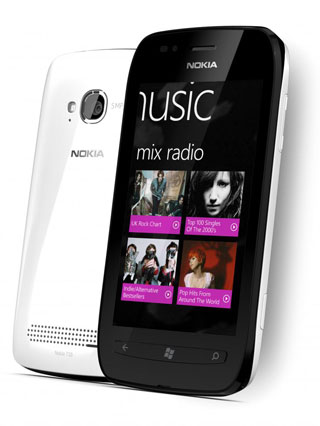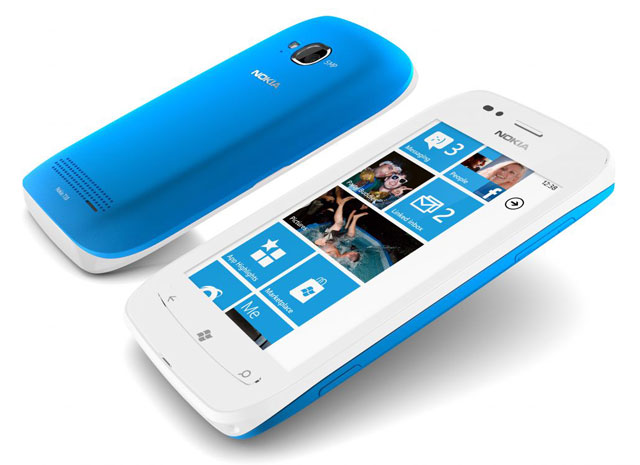 Considering how similar they are, it’s inevitable that the Lumia 710, Nokia’s budget smartphone offering, draws comparisons to its flashier and pricier sibling, the Lumia 800. Boasting most of the same features as the 800, the biggest impediment to the 710’s widespread uptake is going to be exactly the same as that facing the 800: brand recognition of Microsoft’s Windows Phone software.
Considering how similar they are, it’s inevitable that the Lumia 710, Nokia’s budget smartphone offering, draws comparisons to its flashier and pricier sibling, the Lumia 800. Boasting most of the same features as the 800, the biggest impediment to the 710’s widespread uptake is going to be exactly the same as that facing the 800: brand recognition of Microsoft’s Windows Phone software.
Finnish handset manufacturer Nokia has continued to move millions of handsets in the entry-level market, but has lost out at the high-end to Apple and Google Android-powered devices. With its Lumia range, it’s hoping to arrest the decline, and the 710 is aimed at those who want a high-end smart device without the high-end price tag that usually entails.
Compared to the more expensive Lumia 800, the 710, which weighs 145g, does extremely well. Both offer a 3,7-inch screen (the 800’s is an Amoled display), both offer a 1,4GHz processor and 512MB of RAM, and although neither has expandable memory, the 710’s 8GB memory is still respectable compared to the 800’s 16GB. Really, the main difference is in their design.
While the 800 is svelte and arresting with its rounded sides and seamless design, the 710 is, well, a little on the forgettable side aesthetically.
In keeping with Nokia’s decision to throw all of its smartphone eggs in the Microsoft basket, the Lumia 710 runs the “Mango” flavour of Windows Phone. The operating system is superb, and its tiled front page and minimalist layout is a refreshing change from the icon-driven approach of Android and Apple’s iOS. However, with strong suggestions that the Lumia range won’t support Windows Phone 8 when it’s launched later this year, one has to wonder about the 710’s longevity.
But, at only R3 999, it’s an excellent deal when compared to the hefty R6 999 price tag of the 800. Considering you can do almost everything on a 710 you can do on the 800, it suddenly seems the more prudent move, unless the extra 8GB of storage really makes that big a difference to you.
Like the 800, Nokia has opted for a micro Sim in the 710, but, unlike its big brother, the 710 has a removable rear cover, meaning the battery can be replaced. Hooray!
In keeping with its cost-saving approach, the 710 also has a lesser 5-megapixel shooter compared to the 8-megapixel variety found in the 800.
The 710 still shoots 720p video, but while the video quality is pretty good, still images are middling at best, despite its fast-aperture f2,2 lens. Considering Nokia’s substantial experience in the camera-phone market, and with it having pioneered the first camera-carrying handsets, this is a little disappointing.
Furthermore, the iPhone 4 — one of the most popular camera phones of recent years for serious mobile snappers — only has a 5-megapixel camera. Nokia has dropped the ball here and serious shooters will be disappointed with the images the 710 offers.
There’s a dedicated camera button on the right of the 710, along with a volume rocker, and the top of the device plays host to the power/lock button, a micro-USB port and a 3,5mm audio jack.

The battery is rated for 1 300mAh, which means you shouldn’t expect much more than a full day of use from it. But then who isn’t used to carrying a charger around with them by now? The 800 performs a little better on the battery front, but considering its battery isn’t user-replaceable, the battery bout could arguably go to the 710 on this basis.
The best features of the 710 have little to do with its look or feel and everything to do with the functionality its operating system and Nokia’s software ecosystem offer. Chief among these are Nokia Drive and Nokia Music. The first is a fully fledged personal navigation system with free turn-by-turn navigation and a dedicated interface designed for in-car use.
The second, Nokia Music, includes a service Nokia calls MixRadio, a music-streaming application that delivers mixes from a sizeable database and that can be shared with other users.
Available in black or white, and with a range of colourful, interchangeable rear covers, the 710 is clearly aimed at one of two categories of phone users – the young and cash-strapped who still want comprehensive smartphone functionality, and those who are just entering the smartphone universe and want a simple-to-use device that won’t require an expensive contract.
Ultimately, the 710 offers a great user experience for its price, albeit in a somewhat uninspiring design and with a sub-par camera. The biggest problem it faces is attracting users in the market for a similarly equipped handset away from camp Android. Nokia remains an enormously recognisable brand, but it still faces an uphill battle to make it as desirable as it once was. — (c) 2012 NewsCentral Media




